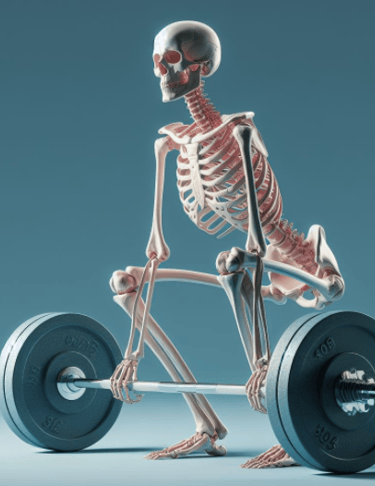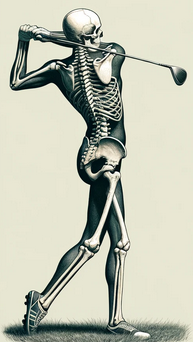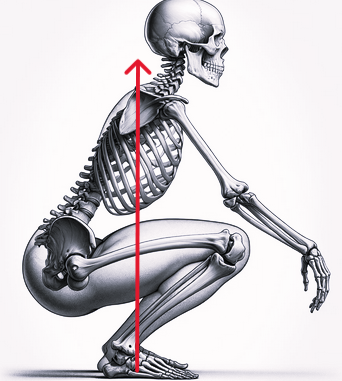Key concepts to improve posture
Concept 1: Feeling the whole structure of the dynamic skeleton, No need to know how the muscles are working.
Adjusting your posture involves being mindful of your body and how it feels in space. You don't necessarily need to have knowledge of the specific muscles involved in order to improve your posture.
A cheetah running at a speed of 100km per hour flows like water, every joint in flux, its entire thorax moving to permit maximum respiration. When posture works unimpeded, effort is distributed reflexively throughout the muscular matrix, and we needn’t think about what and how muscles are doing to make the skeleton at best dynamic structure to create fastest velocity. It is the same for sitting, walking, golfing and others: just focus on adjusting the positions of the skeleton structure, do not worry about what kind of muscles do it.
Small children usually have excellent posture, demonstrating its innate nature. As the tasks required later, we begin to see deformations in posture, which can be said to have some basic causes for modern living: prolonged sitting weaken the skeleton structure and using of cellphones hold our head in a forward position and hunch our shoulders, which can put strain on the neck, shoulders, and back muscles.
Remember that good posture is not about perfection, but rather about feeling comfortable and supported in your body. By practicing mindfulness and awareness, you can gradually improve your posture and feel better in your body overall.


Concept 2: Imagination of the dynamic structure of skeleton
It is different with the images of body actions. So we should know the right positions of the skeleton for special actions by science just like the right structure of the building before building up. If we do not know or can not imagine the right position before actions, it will be very hard to finish this action perfectly just like there is no blueprint before building a skyscraper.
Understanding how the skeleton changes the structure of shape internally is not the same as seeing the external movements of the body. It's crucial, much like knowing the correct architectural structure before constructing a building, to scientifically comprehend the proper positions of the skeleton for specific actions. Without this knowledge or the ability to envision the correct dynamic positions beforehand, executing actions flawlessly becomes challenging – akin to attempting to build a skyscraper without a blueprint.
Just as a building is designed based on scientific and engineering principles, the skeleton is also intricately designed through scientific understanding. It abides by the laws of physics to withstand significant forces. In this analogy, muscles act like workers pulling on the bones, ensuring they are in the right places and forming a stable and functional structure, akin to constructing a building.
However, when it comes to the dynamic actions of the skeleton during movement, we can't draw a physical blueprint. Instead, we rely on our ability to mentally imagine the positions of the bones and the sequence of their movements. This mental visualization is guided by scientific knowledge and the principles of physics, orchestrated through the nervous system and muscle contractions.


Concept 3: Feeling the position of the skeleton actions aligning with image in mind
Checking or verifying the dynamic position of the skeleton during an action can indeed be assessed through sensory feedback. The nervous system, equipped with numerous sensors, plays a crucial role in providing this feedback. Here's how you might assess the correctness of your skeletal position for a specific action:
Comfort and Ease: If the designed imagination of the skeleton's position is correct for a particular action, you would likely feel comfortable and at ease while performing the movement. The absence of discomfort or pain is a positive indicator.
Smooth Movement: A well-designed skeletal position allows for smooth and coordinated movements. If you can execute the action smoothly without any jerky or awkward motions, it suggests that your skeletal alignment is likely appropriate.
Balance and Stability: Correct skeletal alignment contributes to overall balance and stability during an action. If you feel stable and balanced throughout the movement, it indicates that your skeleton is positioned appropriately.
Pain or Discomfort: On the flip side, if you experience pain, discomfort, or a sense of strain, it may signal that the designed imagination of the skeletal position is not optimal. Pain is a clear indicator that adjustments are needed.
Proprioception: Proprioception is the body's ability to sense its position in space. It involves feedback from muscles and joints to the nervous system. Trusting your proprioceptive sense can help in gauging whether your body is in the intended position.
Feedback from Others: Sometimes, external feedback can be valuable. A coach, trainer, or observer may provide insights into your form and alignment, helping you refine your understanding of the correct skeletal position.
Using your body's sensory feedback, especially feelings of comfort or discomfort, is a practical way to gauge the accuracy of your skeletal position during various actions. Listening to your body and making adjustments based on how you feel can contribute to effective and safe movement.


